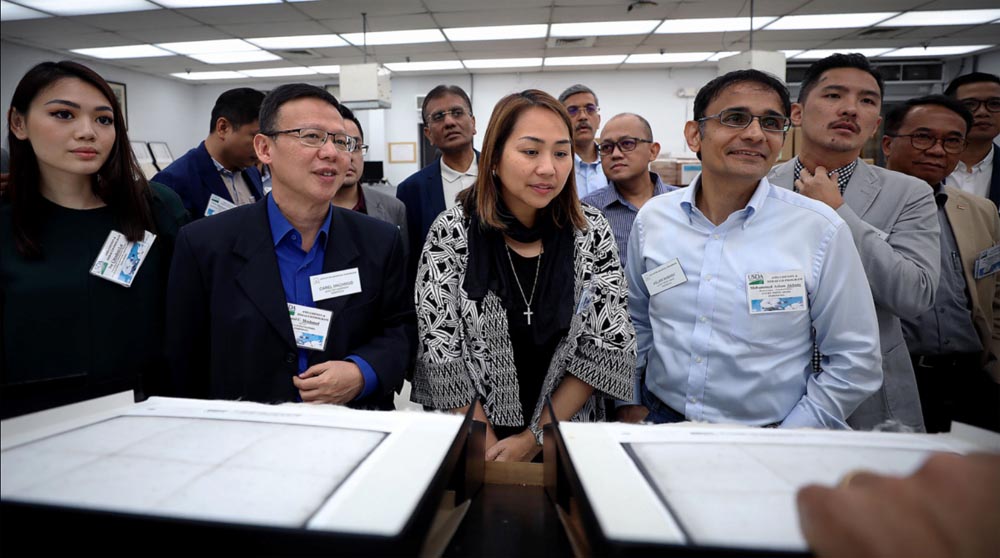No tour of the U.S. cotton biz is complete without a stop in Memphis.
Some of cotton's most savvy customers, textile executives from the 20 largest textile mills in Indonesia, rolled up to the U.S. Department of Agriculture's cotton classing offices in Bartlett Tuesday in a sleek tour bus, and they breathed in deeply.
For many, cotton produced in the U.S. is their favorite, and Memphis, the historic crown of the industry, is the touchstone.
“I’ve been here several times,” said Abhay Agarwal, director of corporate strategy for Primayudha. Besides spinning yarn, dying fabric and sewing garments, the company will produce 180 million yards of fabric this year.
The lion’s share of it will flow to the U.S. in garments with labels so well-known that most children could name them.
Indonesia is the fifth-largest importer of U.S. cotton, and the market share is increasing steadily. In the past three years, the share has gone from 23% to just under 43%, said Will Bettendorf, head of supply chain marketing in South and Southeast Asia for Cotton Council International, the marketing arm of the Memphis-based National Cotton Council.
“That is part of the reason we want to host them. If their industry is growing, we want to be part of that,” he said. “The best way to build a market is meet your customers and explain why U.S. cotton is so good.”
The executives toured the cotton classing operation, the largest of the 10 U.S.D.A. runs across the Cotton Belt, and they were briefed on expected supply and demand for the crop now in the field. They also heard about U.S. innovations in sustainability, one of the new buzzwords in commodity marketing.
“Global brands and retailers are very sensitive about the products they sell,” Bettendorf said. “A lot of consumers, particularly in Europe, are very sensitive to environmental issues. They want assurances that the cotton is produced in a sustainable manner.”
Cotton has always been political. And the Indonesian delegation, which headed to Harlingen, Texas, Wednesday to see the first of this year’s crop coming out of the field, has a few issues of its own.
Between them, they use 2.1 million bales (each weighs 840 pounds) and account for more than two-thirds of Indonesia's consumption of cotton.
They would love to buy more U.S. cotton – and they probably will on this trip – but without a bilateral trade agreement, they will pay 6-20% in tariffs on every T-shirt, dress, jean and shirt they export back to the U.S.
“We would like to buy more U.S. cotton. We wish we could export it back to the U.S. without an export duty,” said Anne Sutanto, vice chairman of foreign trade for the Indonesian Textile Association.
“It’s not for our benefit,” she said. “It would save the U.S. consumer money, not us,” she said, noting that Indonesia is also a democracy with a 70-year history of diplomatic relations with the U.S.
The delegation arrived in Memphis fresh off meetings with trade officials in Washington.
“We got positive signals,” Sutanto said.
The other issue is how much more business big apparel companies will divert to Asia and Southeast Asia from China, where textile exports are now subject to 10% punitive tariffs in the U.S.
President Trump has said they could go to 25%.
“No one knows but Mr. Trump,” Agarwal said.
If they do rise, other textile exporters will have an immediate edge over China, a factor they can’t help but juggle when seeing all the U.S. cotton for sale and hobnobbing Tuesday evening at the University Club with the people who produce it, warehouse it and ship it.
Earlier this month, Bettendorf was in Vietnam, a textile exporter, and saw the tightening capacity firsthand.
“The apparel companies are planning ahead and trying to reserve capacity in other factories,” he said. “The issue is the factories book their space 12-18 months in advance. You can’t knock on a factory door and expect them to turn out 5,000 T-shirts next week.”
Indonesia’s textile mills are operating at 50% capacity, which means they are open to some new business.
Primayudha could take orders for an additional 1 million or 2 million pieces, Agarwal said, “but not more.”
The company, expanding at a rate of a factory a year, doesn’t plan to up its investment over U.S.-China trade tensions.
“We won’t do that, Agarwal said. “The issue will be solved, and then we would have too much capacity.”
The trip, which started in New York Sunday and wraps up Thursday in Lubbock, Texas, is funded by USDA’s Foreign Market Development Program.
“Cotton competes against all the other commodities for money from the same bucket of funds,” Bettendorf said.
“We submit an application every year. U.S.D.A. reviews them and based on the potential for return on investment, it will allocate the funds. Typically, cotton ranks No. 1, 2 or 3,” he said.
“The cost of hosting is negligible to the sales it generates. We wouldn’t do it if we didn’t have confidence we would receive benefits for the U.S. cotton industry. There is a definite return on the investment.”


